|
|
|||
THIS WEEK at HILTON POND
15-21 October 2006
Installment #333---Visitor #
(Back to Preceding Week; on to Next Week)
|
WHEN IT'S DREARY AND COLD |
|
OCTOBER CORNUCOPIA
In October, every day that passes brings us noticeably closer to winter--especially when overnight temperatures drop near freezing and "frost is on the pumpkin." Here at Hilton Pond Center, trees are cutting off water flow to their leaves, killing the chlorophyll and thus allowing those autumnal reds and yellows to appear. On breezy days, one leaf after another breaks its tie with a tree for which it labored photosynthetically all summer, and the now brightly hued foliage tumbles earthward. This week at the Center there's lots of fall activity to describe, so instead of a single topic we offer "October Cornucopia"--an assortment of five observations we made as the seasons were a-changin'.
All text & photos © Hilton Pond Center OBSERVATION ONE: Winter Finches
Over the past 25 years, HOFI have been our most-captured bird at the Center, with 7,393 banded through this week. HOFI are challenged closely by Purple Finches--their more northerly congeners that appear here only in winter--of which we've banded 7,166. American Goldfinches are next in line with 5,905, and for many years a fourth "winter finch," the Pine Siskin, was in fourth place; PISI numbers dropped drastically in the 1990s, however, and their near-stagnant total of 1,541 is now outstripped by four other species (Ruby-throated Hummingbird, Northern Cardinal, Yellow-rumped Warbler, and White-throated Sparrow).
Nonetheless, this week we reached a significant milestone when we banded our 22,000th "winter finch," which means House Finches, Purple Finches, American Goldfinches, and Pine Siskins comprise 45.97% of the 47,869 birds banded since 1982 at Hilton Pond Center. This is all the more amazing when we consider the remaining 52.03% is distributed across the other 120 species we've banded at the Center. It's also interesting that House Finches (male HOFI above, against yellow mulberry leaves) aren't truly "winter finches" any more in the Carolinas. Granted, encounters with other banders' birds at our feeders prove some HOFI migrate from further north, but we suspect these days the vast majority are born and bred somewhere nearby--a major change from the early 1980s when nearly all were migrants. We should note that York County is also home to a relatively small nesting population of American Goldfinches. We catch a few adult and local fledgling AMGO at Hilton Pond during late summer (male in breeding plumage above left), but nowhere near as many as during cold months when they migrate in from northeastern and north central states. OBSERVATION TWO: Cryptic Moth
We marveled at the moth's coloration as we examined it through the camera's viewfinder (above). There was nothing particularly spectacular about the color--no psychedelic hues or bold patterning--but the more we gazed at the moth the more it simply looked like a slightly asymmetrical piece of brown leaf stuck to the window glass. The moth's forewings--spread slightly right and left--were marked with a countershaded line that matched perfectly with a similar line of each on the hindwings. This continuous line looked for all the world like the midvein of a leaf, and there were other fainter lines that resembled smaller branching veins. Humans may see a moth when we look at the photo above, but cover the moth's head and front legs with your finger and you can understand how potential predators might mistake this camouflaged insect for an unappetizing fragment of dead foliage. We find moths notoriously difficult to identify to species--oh, what we'd give for a really good and comprehensive photographic field guide to moths of the Southeastern U.S. Initially we thought this one might be an aptly named Confused Eusarca, Eusarca confusaria, but had doubts. We also wondered if it was some other "confusing" Eusarca relative--i.e., one of the looper moths whose inchworming caterpillars dine in part on foliage of asters and Goldenrod, of which we have plenty at Hilton Pond Center. After viewing the photo above, several Web site visitors had other ideas about the moth's identification, including a few who steered us toward Velvetbean Caterpillar Moth, Anticarsia gemmatalis--a relatively common species even MORE variable than the Confused Eusarca. We now agree this is the true identity of our mystery moth. Larvae of A. gemmatalis feed on leaves of agricultural crops, including Velvetbeans and Soybeans. We grow neither at Hilton Pond, but several nearby farmers have fields of the latter. (Bottom line is that one doesn't need to know the actual name of an organism to marvel over its adaptations. Nonetheless, input from taxonomic specialists is always welcome.) OBSERVATION THREE: Ant Swarm
We don't know what initiated the swarm, other than to note that the nights of 15-16 October were the coldest of the season so far (down to the upper 30s), followed by steady rain all the next day (1.2" in the Hilton Pond Center gauge.) The 18th was much warmer--afternoon readings in the upper 70s--with very high humidity (above 90%) and heavily overcast, almost foggy skies. While pedaling we also noticed fire ant mounds on the highway shoulders were much higher than usual, and they were constructed of fresh soil. (The mound in the photo above--atop the end of a driveway culvert--is about 18" in diameter and nearly that tall.) Again, we're not precisely sure how all these phenomena tie together--cause and effect are often difficult to figure out in nature--but we'll bet the various factors we list above are somehow related. Knowing how fiercely fire ants bite and sting, we're just glad when we bicycled back to Hilton Pond we were unable to find any new invasive ant mounds on the property. OBSERVATION FOUR: Sunflower Seeds
These "dead flowers" with nutlets don't look like much, but at the base of each tiny brown cluster is a small swelling--a single sunflower seed ripening within its own ovary. And each of these seeds--perhaps a hundred per flower head--has within it the genetic potential to sprout into a new Schweinitz's Sunflower--something of great significance to us since this plant is a federally endangered species. We'll collect a few flower heads as soon as the green sepals die, but the rest will stay on the flower stalk all winter in the hope they'll fall to the ground, germinate naturally, and sprout into the next generation of rare sunflowers at Hilton Pond come next spring. OBSERVATION FIVE: New Mammal
We learned a few years later there is also a chance the animal was a "Samson Fox," a Red Fox with a rare recessive genetic abnormality that prevents long guard hairs from growing and causes underfur to be tightly curled. This makes the fox look "woolly" over its entire body or just on body, tail and hindquarters--resulting in either a "complete" or "partial" Samson condition. Samson Foxes have more body fat and higher metabolisms, sometimes leading them to seek out easy food--including human food waste, garbage cans, etc. In any case, this was our first observed occurrence of a Red Fox at the Center, and the first addition to our local Mammal Checklist in quite a few years. As fall arrives, nature always seems more active, but it's probably because we were lulled into a slow pace by the drone of cicadas during a long, hot summer. Within the next few weeks, most of autumn's colorful leaves will have fallen, winter finches will have settled into a steady diet of black sunflower seeds, and insects and wildflowers will be few and far between. So, for now, we'll just enjoy our "October Cornucopia" at Hilton Pond Center and start counting the days until spring brings the next bustle of activity. All text & photos © Hilton Pond Center
Comments or questions about this week's installment?
Thanks to the following fine folks for recent gifts in support of Hilton Pond Center for Piedmont Natural History and/or Operation RubyThroat: The Hummingbird Project. Your contributions allow us to continue writing, photographing, and sharing "This Week at Hilton Pond." (See Support if you'd like to make a gift of your own.)
"This Week at Hilton Pond" is written & photographed You may wish to consult our Index of all nature topics covered since February 2000. You can also use our on-line Hilton Pond Search Engine at the bottom of this page. For a free, non-fattening, on-line subscription to |

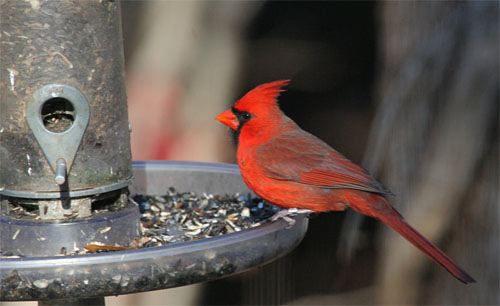
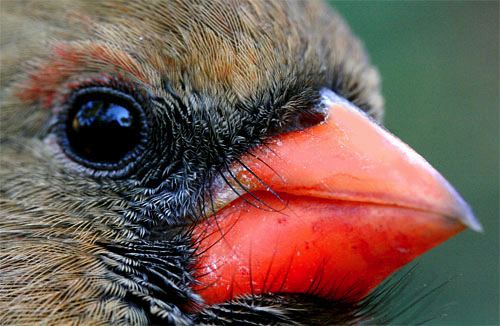
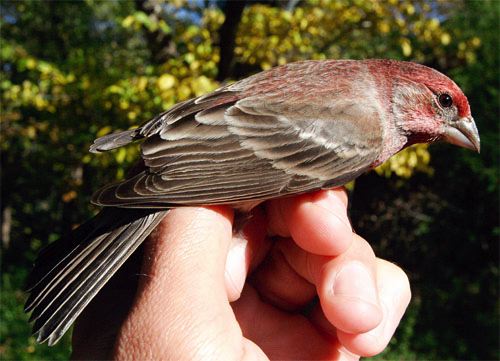
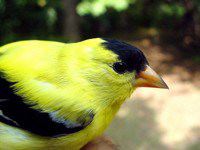 The House Finch, a western species released in New York in the 1940s, has expanded its range into the entire continental U.S.; in a little more than 60 years HOFI have become one of the commonest breeding birds in the urbs and suburbs of the Carolinas.
The House Finch, a western species released in New York in the 1940s, has expanded its range into the entire continental U.S.; in a little more than 60 years HOFI have become one of the commonest breeding birds in the urbs and suburbs of the Carolinas.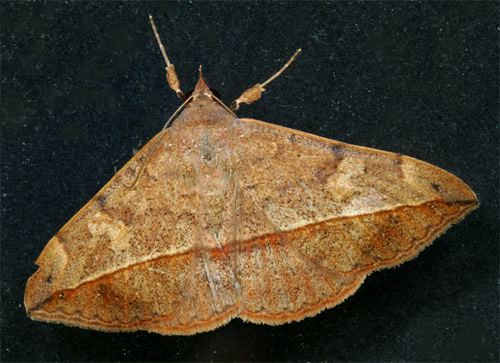

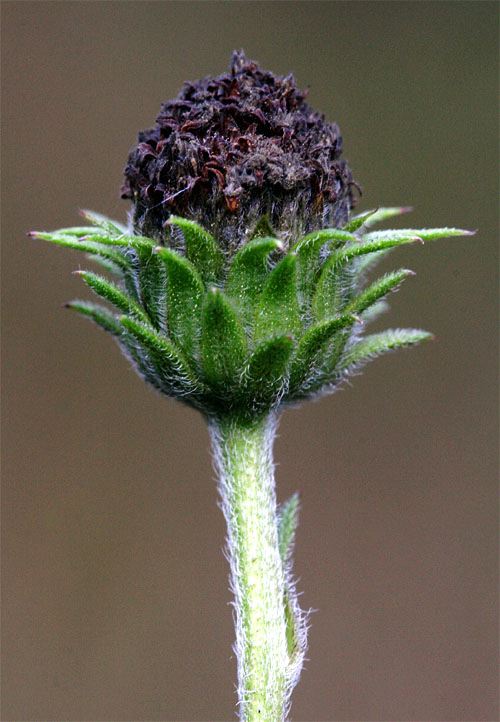
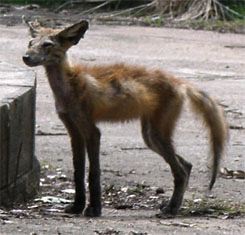 That morning, while at the window in front of our computer desk in the Center's old farmhouse, movement on a nearby trail caught our eye. At first we thought a feral cat was stalking birds under a feeder, but we soon saw it was more dog-like. As the animal loped up the path, it came into a clearing and revealed a white tail tip--a sure sign it was a Red Fox, Vulpes vulpes. Unlike the typical Red Fox (below left), this particular animal had almost no hair on its head or body, and the tail wasn't fluffy. We suspect it was a young fox shedding heavily and possibly suffering from mange. It scooted from view before we could grab our camera.
That morning, while at the window in front of our computer desk in the Center's old farmhouse, movement on a nearby trail caught our eye. At first we thought a feral cat was stalking birds under a feeder, but we soon saw it was more dog-like. As the animal loped up the path, it came into a clearing and revealed a white tail tip--a sure sign it was a Red Fox, Vulpes vulpes. Unlike the typical Red Fox (below left), this particular animal had almost no hair on its head or body, and the tail wasn't fluffy. We suspect it was a young fox shedding heavily and possibly suffering from mange. It scooted from view before we could grab our camera. 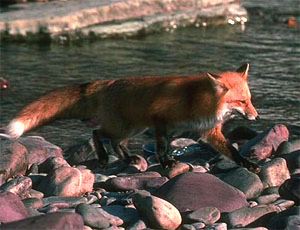 Coincidentally, we received a photo of a nearly hairless Red Fox last month from Carolyn and Don Caskey of Lula GA, asking us to confirm what it was (see Don's photo above right). Our Hilton Pond fox looked similar but with much less body hair, and we might not have identified it conclusively without that tell-tale white tail tip.
Coincidentally, we received a photo of a nearly hairless Red Fox last month from Carolyn and Don Caskey of Lula GA, asking us to confirm what it was (see Don's photo above right). Our Hilton Pond fox looked similar but with much less body hair, and we might not have identified it conclusively without that tell-tale white tail tip. 


 Please report your
Please report your Oct 15 to Mar 15
Oct 15 to Mar 15
